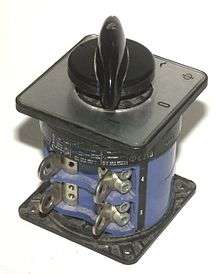Cam Switch

Cam switches are mainly used within the low voltage range. On a shaft, switching cams are made of abrasion-resistant conductive material. By rotating the shaft, the contacts are opened or closed by the cams. Often, a plurality of cams are seated on a shaft, which simultaneously switch or switch several pairs of contacts.[1]
History
Friedrich Natalis (1864-1935), who had been working for the Schuckert-Werke (later Siemens-Schuckertwerke) since 1897, had already developed the cam-switching principle in Germany before 1900. In 1895, however, Johann Sigmund Schuckert founder of the electrical engineering company Schuckert & Co supplied cam switches with cam rollers and spring-loaded individual switches (DRP 88586). Thus the term cam switch has been used for such and similar devices over the years. Schuckert also supplied the "carbon control switch" designed by Natalis since 1901 with copper-carbon switching devices with spark-blowers (common spark blowers for direct current or single-spark blowers for direct and alternating current). The main current cam switch retained some significance, even when the rifle control pushed it where it was more economical. In the miniature machine construction, the cam switch probably did not enter until the beginning of the 1930s. In 1931 the American company General Electric GE released their switch SBl, a 20A auxiliary current control switch, basically a miniaturized image of the large main current control switches. The devices had simple interruption and silver crossover, in some cases they were equipped with a snap mechanism. Around 1940, the first cam switch from Ghielmetti, Solothurn / Switzerland, was replaced as a replacement for the conventional roller switch in Europe. Switches could also be supplied as auxiliary current control switches with corresponding circuits. They are to be marketed under the trade name Ghielmetti-Clavier. In September 1948, Kraus & Naimer from Vienna delivered the first company-owned cam switch of the C15 (15A). In 1949, the company also presented the world's first cam-designed cam switch. At the beginning of 1950, Kraus & Naimer cam switches C30 (30A) were followed with the same design. The Kraus & Naimer cam switches C16 to C200, which came into the market in the spring of 1951, had a decisive influence on the advance of the cam switch and the release of the roller switch in electrical engineering. They had a double interruption and a motor switching capacity appropriate to the rated current. The large number of possible combinations and the extensive additional equipment as characteristic features were responsible for the later development of cam switches as an industrial standard.[2] Kraus & Naimer developed the world's smallest cam switch (model CA4N),[3] which is in the market since 1994.
References
- ↑ Kaspers, Walter: Messen Steuern Regeln für Maschinenbauer, p. 178, last accessed on 23 November 2016
- ↑ Ose, Karl 100 Jahre schalten, steuern, schützen: ein Beitrag zur Geschichte der Niederspannungs-Schaltgeräte in Deutschland. Verlag Brimberg, 1982
- ↑ Company History, last accessed on 23rd of November, 2016